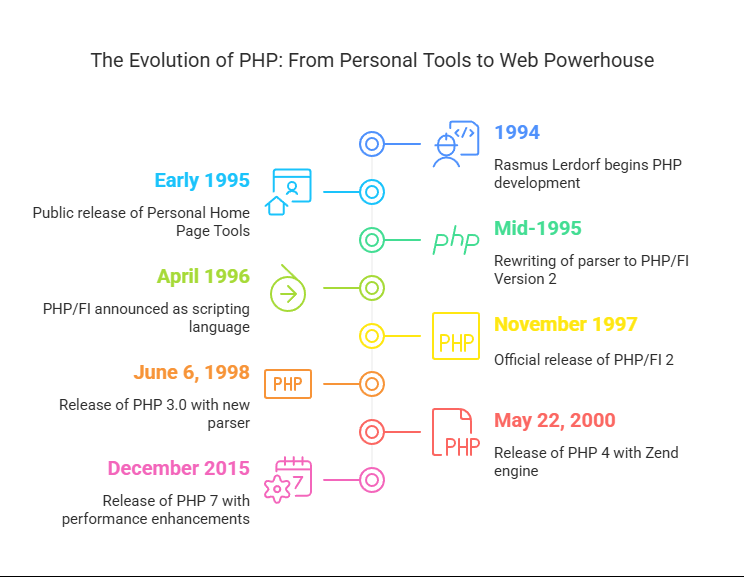History Of PHP
History of PHP has developed into a vital component of dynamic web development, powering a significant amount of the internet today, from its modest origins as a side project to track website traffic. Because of user demand and the commitment of a global open community, PHP has undergone constant change.

The Humble Beginning
In 1994, PHP’s adventure began with Rasmus Lerdorf. Lerdorf initially wrote the code for his own homepage in order to monitor who was seeing his online CV. Early in 1995, the Personal Home Page Tools the initial version made publicly accessible were released. These tools were a collection of compact, tightly built CGI binaries that featured simple functions like a counter and a guestbook.
A crucial component was a Perl-like language created especially for managing form submissions, even though at first it lacked standard components like for loops. The need for more logic that is directly implemented in web pages was rapidly driven by user demand.
Evolution to PHP/FI
The parser was rewritten in the middle of 1995, which was a major milestone that resulted in PHP/FI Version 2. Another software that Lerdorf wrote that translated HTML form data is where the “FI” part of the name originated. Support for mSQL and Postgres95 databases was added, and the Personal Home Page tools were combined with the Form Interpreter in this version.
In April 1996, PHP/FI was announced using the name “Server-side HTML-Embedded Scripting Language,” which was the first time PHP was called a scripting language. It was advertised as the easiest and quickest tool for building websites with databases. Though development was still mostly a one-man show and the underlying parsing engine continued to have stability issues, PHP/FI had expanded and drawn a considerable user base by the middle of 1997. The official release of PHP/FI 2 took place in November 1997.
The PHP 3 Revolution: A New Parser and Collaboration
significant shift was brought about by Zeev Suraski and Andi Gutmans in the middle of 1997. When they came across PHP/FI while working on a university project, they opted to totally rewrite the scripting language parser since they felt that its language features were limiting. In the summer of 1997, this rework got underway. On June 6, 1998, Zeev and Andi collaborated with Rasmus Lerdorf to produce PHP 3.0.
Hypertext Preprocessor is the new name that was introduced with this edition. In order to indicate that PHP was a distinct and more powerful product, this recursive acronym was selected. Importantly, this was the period when PHP’s syntax and semantics were codified, creating a strong basis. Also, Zeev and Andi created and implemented a new extension API that made it much easier to add support for multiple databases and technologies, such as Oracle, Sybase, Solid, MySQL, mSQL, PostgreSQL, and ODBC data sources.
PHP became a truly open source project with contributors from all over the world as a result of the simplicity of extension, which attracted many engineers who weren’t part of the initial core group. All of the main web servers and operating systems were supported by PHP 3, which was regarded as a dependable, quick, and programmer-friendly platform that could reduce development time. After launching with over 50,000 domains, its installed base rapidly expanded to over one million.
Continuing Evolution
PHP 3’s popularity encouraged more development. With the release of PHP 4, on May 22, 2000, the Zend engine and the “compile first, execute later” philosophy were introduced. PHP 5 included a much better object-oriented model and a total overhaul of the Zend engine. A PHP 6 development project was intended to improve Unicode support, however it was ultimately shelved. PHP 7, which focused on significant performance enhancements through yet another engine redesign, was the next significant advancement. It was released in December 2015.
PHP is still a server-side scripting language that was primarily created for the web. Code is run on the server and integrated directly into HTML files. Languages like C, shell, Perl, and Java are all incorporated into its syntax. Powering a sizable majority of websites worldwide, PHP is a fundamental component of dynamic web development as an open source project with a developed community and extensive documentation.
Read more on What is PHP? What is server side scripting language in PHP?
